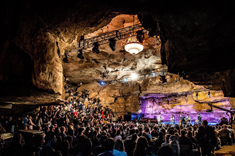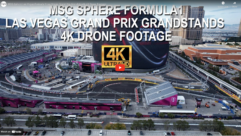
SVC Podcast – Show Notes – Show 176-1
In this edition of the SVC Podcast, Contributing Editor Bennett Liles talks with Nic Dugger of TNDV in Nashville about their fleet of remote TV production trucks and the role of TNDV in the award-winning PBS show Bluegrass Underground. The venue is the three-million year old Volcano Room hundreds of feet below ground at Cumberland Caverns in McMinnville, Tennessee. Nic discusses the challenges of producing the popular music show in that unique setting. Images by Michael Weintrob.
TO GO TO PART 2 OF THIS PODCAST
Links of interest:
- TNDV Television in Nasville, Tennessee
- The award-winning PBS show Bluegrass Underground
- A look behind the scenes at Bluegrass Underground with Nic Dugger
Download Podcast Here:
https://s3.amazonaws.com/nb-svc/public/public/176-1_TNDV_Nic_Dugger_Blue…
Transcript-
This is the SVC Podcast from Sound & Video Contractor Magazine with Nic Dugger of TNDV Television. Show notes and equipment links for the podcast are on the web site of Sound & Video Contractor Magazine at svconline.com.
The hit PBS show Bluegrass Underground is enough of a challenge to produce with a variety of music groups but doing it in a three-million-year-old cave adds a very different angle to it. Nic Dugger from TNDV Television in Nashville is going to tell us how it’s all done with lights, sound and power when TNDV pulls one of their fleet of remote trucks in to do the show. That’s next up on the SVC Podcast.
Nic, it’s great to have you with us again on the SVC Podcast. It’s been a few years since we talked and I think you were doing a big show at the Georgia Dome. Ever since we did that I’ve wanted to get with you about this remarkable PBS show called Bluegrass Underground and you’ve been doing that for several years now. But before we get into that one, what’s been happening lately at TNDV Television?
Well, it’s good to speak to you as always. We’ve had a very busy few years since the last time we spoke. Our fleet count is up to eight trucks now and an additional six fly packs that are working coast-to-coast every week. We closed out a great 2016 and we’re averaging these days about 350 productions a year. So we’re staying very busy. Just in the last few weeks we wrapped up some live events for Harley Davidson. We’re doing a lot of racing work with Harley. Some outstanding concert events in Los Angeles and Nashville and Washington, D.C. And then coming up this week we’re headed toward Phoenix for the Final Four for some concerts there, the Stellar Awards of gospel music in Las Vegas, and as you mentioned season seven of Bluegrass Underground starts loading in two days. [Timestamp: 1:55]
Yeah, I did some fishing around and saw the production schedule for that and I said we’d better get this done, because you guys are going to be right in the middle of the production on this again in just a couple of days from when we’re recording this.
That’s exactly right. This is going into our sixth opportunity to work with the team in the cave. We have a fantastic production partnership with not only the camera team and the lighting team, but the sound guys as well. It’s like a little family reunion every year to get together and work on this project. It’s one we really enjoy. [Timestamp: 2:24]
They seem to be very busy down there in the cave all the time. While they’re not always recording video, they always have concerts going on in there and doing radio broadcasts.
They do. It’s a venue that’s available and they do a lot of events there. We only shoot for the television portion once a year. It’s a very intensive three-and-a-half day shoot. But they have other events in the cave all the time. It’s open to the public. They do tours through there all the time. And in addition to our televised specials we’ve even been known to go back and shoot some one-off events in the cave as well. [Timestamp: 2:52]
And that series has been hugely popular on PBS with the show’s seventh season coming up. I believe Todd Mayo was the creator of it. What an idea to start producing a music show in a natural venue that took three million years to “build”.
Well, it’s actually interesting. The team of Todds – there’s two gentlemen both Todd Mayo and Todd Jarrell – they formed Todd Squared productions and they are the production company behind Bluegrass Underground. They had the original concept and put the team in place to do it. So we affectionately refer to them as “the Todds.” And as you mentioned, this cave that has existed as a tourist attraction for decades gets transformed into a music venue once a year. And we bring in audio and lighting, and of course one of our eight broadcast trucks parks onsite to capture the video side of things every March. And that will turn into an entire season of the now nationally-televised multi-multi Emmy winning Bluegrass Underground that you can see all over the country on PBS affiliates. [Timestamp: 3:49]
And we’ll have some links to that on the show notes here. I guess the obvious question here is what’s it like producing a music show 300 feet below ground?
Well, for us a couple things came to light when we first attempted this project. The first discussion was where do you put your control room? Do you put it down in the cave or do we bring a truck in? And when we bring a truck to a venue like Bridgestone Arena or Ryman Auditorium, it’s not difficult at all. They have parking and power and cable ramps ready for that. But when you’re in a cave on the side of a mountain, getting a truck back there is no easy task, but it’s one that we have perfected over the years. So we back a 40-foot expanding-side truck back to the cave and then run cables. Granted, the cave is 300 feet below ground, but that’s from the top working down. If you follow the cable path it’s closer to 1,500 to 1,700 feet from the truck to where the cameras are actually located. So it’s a lot more tricky of a cable run than it sounds when you’re just talking about digging down from the top of the hill. So we back that truck in, place it onsite the day before our first sound check and start pulling cable. And the first time we did the show it was a lot trickier because at that point in time, six years ago, we ran an individual camera cable. We use SMPTE fiber per camera, plus our audio fibers, plus our analog audio snakes, plus power. They have to get power down into the cave. And even though they have permanently installed residential-style power – they don’t have production power in the cave. So we actually run feeder, heavy-duty copper cam lock cable all the way down that path and into the cave to provide the necessary amperage to the lighting team more than anything. But then we also use some of that power as well. So it’s a massive cable pull that takes about a full day and a half to get done. The good news is as technology has improved we have found ways to reduce the number of cables necessary and most of that we owe to fiber and the fiber optic tools from companies like MultiDyne that allow us to run six or 12 cameras on a single tactical fiber. We’ve also got audio adapters, intercom adapters, data adapters that all run on single-mode fiber. So we’ve been able to significantly decrease the amount of infrastructure that has to be put in place to heavily increase our time that we can get loaded in and ready to shoot. [Timestamp: 6:07]
That must make a big difference only having to string fiber down there but you still need some strong backs to heft all of the copper power cabling. That stuff can really wear you into the ground.
We have actually a series of modified Jeeps that can fit, believe it or not, in the mouth of the cave and down that path. But it’s a very narrow road so you don’t want to come into contact with another Jeep on your way down because there’s nowhere to go. But we do have the ability to use gas-powered Jeeps to move some of this hardware in and out and then that becomes doubly beneficial because all throughout the weekend every band obviously has a full complement of equipment – guitars, bass guitars, keyboards – that have to go up and down that path. So even after we get TV, audio and lighting installed, we have a constant rotation of band gear coming and going up and down that path all weekend long. [Timestamp: 6:56]
With all of that going on at the same time I would think that the entrance to the cave would easily become a huge bottleneck without some pretty careful planning.
Well, you add 700 of the biggest bluegrass music fans in the country to that mix and it gets very crowded. But I think those 700 attendees really enjoy the experience of seeing that TV truck parked out front of this cave and seeing those Jeeps running band gear up and down the path. It really makes for a special experience for them. And I’d put the cave on the save list of venues like Red Rocks or even the Gorge in George Washington as one of those must-see venues. Until you’ve experienced a show down in the cave it’s really hard to put it into words how special that opportunity is to see a band and experience music like that. Because you can’t recreate that in a brick-and-mortar building. [Timestamp: 7:42]
Yeah, and the lighting is absolutely incredible. I mean the way the lighting meets the acoustics down there and it’s got to be like no other performing space in the world.
Well, you know, you think about it. There’s no naturally-occurring light in a cave. When you get that deep it is pitch black. So that allows are lighting director, Allen Branton – and Allen is a multi-Emmy winning lighting designer that’s done every major award show you’ve ever heard of. He is an internationally-renowned lighting designer that comes in and helps us light this thing. He gets to start with a completely blank palette. I mean there is not even the glow of an exit sign. It is pitch, pitch black like you’ve never seen before. And I think as a lighting designer that’s a unique situation. They don’t have any sunlight, any ambient light. You know, even at the Ryman you’re in downtown Nashville. You’re battling with daylight pouring in through those stained glass windows. Down in the caves he gets to start from scratch and I think it’s an opportunity not many lighting designers get to work with, and Allen does a great job and takes full advantage of it. [Timestamp: 8:37]
And TNDV Television has a whole fleet of remote production trucks. Which one did you use for the Bluegrass Underground show or have you used different trucks for that?
I did mention our fleet is up to eight HD and 4K trucks now. We use Aspiration. Aspiration is a seven-year-old 40-foot expanding side truck. It has a nice 3ME HD switcher, a big audio desk from Studer, 64 inputs in that audio suite. And Aspiration typically supports form 10 to 14 cameras and seats a crew of about 17, but fits in a 40-foot bumper-to-bumper configuration so it’s much smaller than a typical full-sized, 53-foot expando truck. And we can fit it down the path to Bluegrass Underground much easier than we could one of our full-sized trucks. That also is beneficial when we’re in downtown Nashville or when Aspiration is in Los Angeles trying to bob and weave through traffic. It’s a little more nimble of a truck, but it still has all the fire power of a full-sized truck. [Timestamp: 9:35]
And you’ve got Aspiration, Inspiration, Vibration. Where did the naming scheme for these trucks come from?
Well, that’s something that is – the TV truck fleet owner, I have the unique opportunity to come up with the naming system for our fleet. I actually grew up in a high school in West Tennessee that had a very large statue right in the middle of campus and it was simply labeled “Aspiration.” Nobody really knew what it meant or why it was there, but after we built our first truck and it stayed busy, and determined we needed a second truck, we found out if we have a second truck we have to start naming these trucks now. So we actually named that second truck after that statue, Aspiration, and then went back and named the first truck Origination, since that was the original. And since then we’ve added an audio truck we call Vibration, an uplink truck we call Constellation, other switching trucks called Inspiration and Elevation, and just last May we launched our biggest truck, a 4K double-expando 53-foot truck that is so massive on the inside we named it Exclamation because that’s the reaction we hope clients have when they step on board and see how big this truck is that seats 30 people in a single truck platform. [Timestamp: 10:44]
Well, you’re not going to have any trouble getting attention with the truck or the venue in this case. I believe they perform in what’s called the Volcano Room.
That’s correct. As you hike in, as if you were one of the tourists visiting the cave, it’s about a 30-minute hike to get down into this space that opens up into a very large room known as the Volcano Room. And that space seats about 700 attendees in addition to the technical crew. Many of those folks are in seats, but as you’ll see on television many folks are sitting on the wall or sitting on a ledge or leaning up against a stalactite or a stalagmite to catch the show. A really pretty space. Years and years ago they hung a massive chandelier in this room that stays there permanently. You know, the stage itself has been carved and hewn out of the stone so it’s a permanent fixture. We even had a rigging company a number of years ago come in and install legitimate points into the stone ceiling and rate them so our lighting team knows exactly how much weight they can hang from the stone ceiling of that cave. So even though it’s a very rustic and primitive environment – it’s dusty and it’s dirty – we’ve put all the comforts of a venue home in there to make our job producing the television show even easier. [Timestamp: 11:55]
Yeah, I would think there would be some kind of code considerations since you have live audiences in there and it’s not exactly your normal type of building. That could get interesting.
Well, it’s not ADA compliant and that’s something that goes along with the fact that this tourist venue itself is not capable of being ADA compliant. And of course we have the signage and the information regarding that. And I’ll give Cumberland Caverns credit. They make sure there are plenty of activities at the guest area that if someone is not physically comfortable making that trip down into the cave, they can still enjoy their visit to the park, learn about the environment, have activities. But when it comes to the power and the rigging we’ve installed everything is compliant to code. We have the city, and the city of McMinnville is extremely supportive of this project. They come in and check out any of the installation work or contracting work we’ve had done and make sure that it’s safe for all the attendees to enjoy a fun weekend. [Timestamp: 12:45]
I guess with it that far below ground level the temperature must stay pretty much constant in there no matter what the weather is outside.
It’s interesting. Because of the time of the year we do this in Tennessee we can experience exterior temperatures in the 70’s or 80’s all the way down to the 30’s, but the cave stays a very consistent temperature. But what this means is equipment can’t come up and down overnight. We wouldn’t want eye pieces and viewfinders and lenses to have to deal with that dramatic temperature change and humidity difference. So once we load in on Wednesday and Thursday, the equipment stays in until we come out on Sunday. [Timestamp: 13:19]
I’m sure the production crew has some interesting talks about this for a long time after one of these shows. So what’s coming up for the seventh season show? Do you know who the performers are going to be yet?
Well, they keep a lot of that a surprise for the guests who are going to be there onsite, but one thing we have learned is the producers at Todd Squared, they know how to build a team of artists that keeps the attendees engaged and it’s always everything from big, famous national acts – this year I think we’ll see some of the folks from Blues Traveler appearing and they also feather in local and regional acts. And even though it is Bluegrass Underground they make sure that it’s not only Bluegrass. They feather in Americana music and some rockabilly music, and they really put together eclectic nights of music for all three nights of the taping to make sure not only the TV audience will enjoy it for the next year to come has a great experience, but that the crowd onsite gets a good taste of a lot of different music while they’re there as well. [Timestamp: 14:13]
They do have a wide variety of musical acts in there. I’ve looked at a lot of the videos from this and I’m just knocked over by all of the great bands. The sound is great, the lighting is fantastic, just a beautiful thing the way it comes together. In Part 2 we’re going to get into some of the technical details on the acoustics and things like that. Great having you here. It’s Nic Dugger from TNDV Television in Nashville and Bluegrass Underground a long-running and award-winning PBS show. Thanks for being with us, Nic.
My pleasure. Everyone have a great day.
Thanks for getting with us on the SVC Podcast. Show notes and equipment links are on the website of Sound & Video Contractor Magazine at svconline.com. Next week we’ll be talking to Nic about the Volcano Room, all the gear in the truck and more about the challenges of a three-million-year-old venue. All that’s next time on the SVC Podcast.










